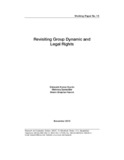| dc.description.abstract | BRAC Human Rights and Legal Services Program (HRLS) was initiated to form the ward-based Legal Rights Implementation Committee (LRIC) comprised of 19 members to ensure justice for the vulnerable women of the community. The study explores the dynamics of the committee formation, the strength and weakness of HRLS and to analyze the nature of performance and sustainability in achieving justice for the women. The study was exploratory in nature, following Tuckman’s four stages group dynamics model to achieve the basic objectives of the group. The study investigated the activities, performances and contribution of seven committees in Khulna, Moulvi Bazar and Jamalpur each over seven months period. The findings show that as the LRIC committee constituted of different professional groups, therefore, it became more effective to protect the interest of most vulnerable groups by providing the legal support to them. A number of collective actions visualized the potential contributions of the members of LRIC. But at the same time the study shows how the LRIC faced the sub-group syndrome among the members because of their hierarchical position in social strata. However, inadequate group cohesion and lack of intra-group bond and interactions constituted a comparatively weaker social space for LRIC group. The women members were seemed to be proactive in their individual and group level performance. Moreover, the community people acknowledged the necessity of LRIC but they had no basic knowledge of its modality and activities. Finally, it can be said that despite some limitations of LRIC, it has proved its capacity to potentially be an effective group for protecting the legal rights of the most disadvantaged. | en_US |

